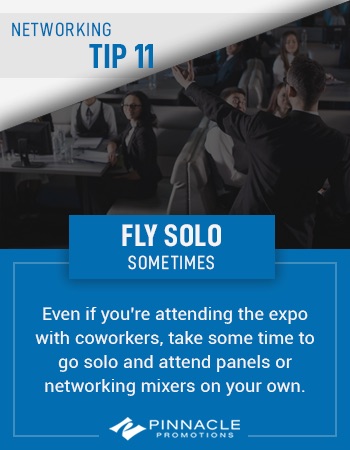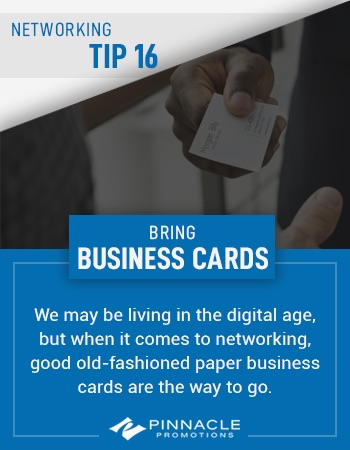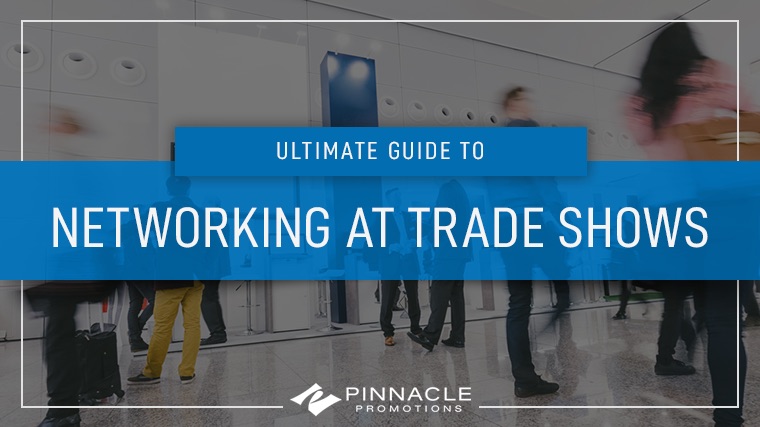Networking can be intimidating in any context, and especially so at trade shows since you’re already exhausted from looking at all the vendors and staffing your booth. While it may seem like networking comes naturally to some people, it’s a skill that you have to practice, and just about anyone can get better with time. To help you make new connections at your next expo, we’ve gathered our 18 best tips for networking at trade shows.
1. Practice beforehand.
If you’ve never networked much before, trying to do a trade show right off the bat is definitely jumping into the deep end. You’ll be much less stressed, and your interactions will go much more smoothly, if you can get some practice before the main event. See if there are any local expos relevant to your industry happening in town that you can attend. Chambers of commerce, professional associations and other groups also have regular networking meetups (though you often have to become a member to go). Rather than stressing out about selling your company or yourself, focus on chatting with strangers and having a good time at these practice events.
2. Figure out who you want to meet.
You should have a good idea of what speakers and vendors will be at the conference as the date nears. Depending on how long the trade show is, create a priority list of three to four people you’d like to make contact with while there. If you already know them (say, they’re a current client), reach out before the expo so you can schedule a meetup. If you don’t, strategize a way to meet them, such as going up to a speaker after a panel or seeking out a potential partner’s booth during a quiet period when you can talk.

3. Arrive early and stay late.
Trade shows are already busy enough. Once you add in the networking, the schedule can become truly overwhelming. Give yourself some breathing room by flying out the day before and coming back the day after the expo. This will let you settle into your hotel, set up the booth, check in at the expo and complete other necessary tasks before the crowds get big and the lines get long. It’s also easier to network with potential new contacts when there are fewer attendees around since you’ll have less competition for their attention, making before or after the trade show the perfect time to meet someone.
4. Maximize your schedule.
Take a look at the trade show’s schedule and plan out your itinerary before you head to the expo. If you’re staffing the booth, block off those times, as well as any panels or expo events you want to attend. Make sure client meetings are on the plan as well. You might also want to schedule some additional “office hours,” where you work in a nearby cafe and interested people can drop by at their convenience. Don’t forget to leave time for meals and other breaks!
5. Know your pitch.
This should be covered in your staff training before the expo, but make sure you and your fellow attendees have a clear idea of what your marketing message will be for new contacts at the trade show. Practice with each other to make sure you’ve got the main points down, so you don’t freeze up the first time you have to talk to a visitor. If you have promotional materials you’ll be handing out—such as a press kits on a custom USB drive—review those materials as well so you know what’s included.

6. Tell your story.
Networking at trade shows isn’t just about pitching your company or product. Attendees will also want to know about you as a person. Think about how to tell your professional story in a concise but engaging way, covering important points such as how you ended up at your current company and what drew you to the industry. If you don’t like talking about yourself, you can practice giving a short “elevator pitch” about yourself, as you did for your company or product, at your trial run networking events.
7. Be authentic.
It’s pretty easy to tell when people aren’t genuinely interested in what you have to say, or just want to talk about themselves (or worse yet, are trying to lie about their credentials or company!). Focus on being yourself and sharing a bit of your personality (within reason). Trade show attendees are so inundated with canned sales pitches that a bit of authenticity will be a breath of fresh air and make you stand out from the crowd.
8. Don’t be too transparent about your agenda.
No one attends a trade show for the sake of just being there. Everyone has some kind of greater objective: meeting new customers, launching a new product, growing their own personal network, etc. Everyone knows you have some kind of agenda, and they have their own as well, but there’s no need to leap into it straightaway—this isn’t door-to-door sales. Coming on too strong and selling too quickly is a real turnoff, so chill out and focus on getting to know speakers and fellow attendees.

9. Dress professionally but comfortably.
You’ve probably heard the advice “it’s better to overdress than underdress” when it comes to job interviews, but this doesn’t really hold true for networking at trade shows. In fact, dressing too fancy can make you seem unapproachable and intimidating, especially if you’re trying to mingle with strangers on the trade show floor (which is why corporate apparel is a great option). The acceptable dress code will vary from expo to expo, so do some research beforehand and aim to dress in the middle of the spectrum—neither the fanciest nor the most casual outfit there. And whatever you do, bring comfortable shoes because you’ll probably be standing and walking a lot. If the event is in cooler weather, consider sending your employees in a jacket - one that's custom to your brand. Be sure to check out our best work jackets collection for ideas.
10. Relax and be approachable.
If you’re noticeably stressed out, people will be less likely to approach you, so relax and try to enjoy yourself. Smile if you make eye contact and don’t cross your arms over your chest. Beyond that, don’t fret too much over your body language. A lot of trade show networking success comes from attitude, so coming into every interaction with optimism and genuine interest in the other person will go a long way—even if you don’t walk away with a new customer or expo BFF.

11. Fly solo sometimes.
It’s less intimidating to approach someone standing by themselves than it is to break into a group who’s already chatting. Likewise, being approached by one person is less overwhelming than having a big group surround you. Even if you’re attending the expo with coworkers, or plan to meet up with contacts there, take some time to go solo and attend panels or networking mixers on your own. And if you were already planning to attend the trade show by yourself, take advantage of the opportunity to make some new friends, even it’s just for the expo.
12. Brainstorm icebreaker questions.
“So, what do you do?” is the most classic of networking icebreaker questions—and that’s what makes it so boring. Before you go to the event (or perhaps on the plane on the way there), brainstorm some unusual icebreaker questions that will get the conversation started and make you stand out among the crowd. If you can tie your questions into the event—such as asking what brought the other person to the expo or what they thought of the keynote speaker panel—that will open up a natural way to start the conversation without it feeling too forced.
13. Think about how you can bring value.
In networking interactions, many people are focused on what they can get out of the other person: a trial of their new product, introductions to more people, industry tips, etc. Instead of only focusing on what you need, think about how you can help other people at the trade show as well. Do you have a lot of industry connections you can introduce trustworthy new contacts to? Are you a subject matter expert on a relevant topic? Do you know a lot about the city where the expo is being held, so you can recommend restaurants for dinner? Bringing value to the interaction like this will definitely make you stand out in people’s memories after the show.

14. Watch for an opening.
No one likes being interrupted, so choosing the opening moment is key for a successful networking interaction. Approaching someone standing by themselves, looking around, is an obvious choice, but that’s not always an option. Wait at a respectful distance for groups to break up, or for an obvious lull in the conversation, before trying to insert yourself. Don’t forget to smile and have icebreaker questions ready to go so you’re not left staring at each other waiting for someone to say something.
15. Leave at the right time.
Starting a conversation is only half the equation. You also need to know how to wrap things up at the right time. If the other person is acting distracted, looking around or giving short answers, that’s a good sign that they’re no longer engaged and that it’s time to wrap things up. And if you find yourself doing these same things, don’t feel obligated to continue the conversation. Offer an excuse, such as filling your drink or saying hi to another acquaintance you see, and say your goodbyes.
16. Bring business cards.
We may be living in the digital age, but when it comes to networking, good old-fashioned paper business cards are the way to go. Bring plenty of extra business cards so you can hand one out to each person that you talk to. Make sure they include your name, title and company, plus the best ways to contact you. You’ll probably receive a lot of business cards in return, so decide where you’ll carry them and how you’ll sort them. Many people like to make a note on the back of the business card to jog their memories about the conversation, but if you prefer the digital route, you can keep a running document on your phone instead.

17. Have a lead capture system in place.
Scribbled notes on business cards are just the first step. Have some kind of digital master file where you keep track of all your contacts, whether it’s as simple as a basic spreadsheet or as fancy as a marketing automation platform. Inputting your contacts into some sort of database will make it so much easier to go through them and figure out how to follow up after the trade show. Plus, you’ll have a digital backup in case you lose any of the cards—always a risk at an expo.

18. Continue building the relationship.
You’ve survived the expo, made it home in one piece and slept for hours on end. So, your work here is done, right? Wrong! You’ll still need to follow up with all your contacts, but don’t give in to the temptation to give the sales pitch right away. Send a simple thank you email, reference the conversation you had at the trade show and offer to keep in touch. Using your newsletter or blog is a great way to nurture your leads without going straight for the sales pitch. So, if you have that content, put it to use. Lastly, you might consider keeping a stock of branded corporate gifts on hand to give as thank you gifts after making a trade show connection.
Networking at trade shows can lead to new customers, yes, but also to great conversations and industry friends. Follow these 18 best practices the next time you attend an expo and all of your coworkers will be impressed with your newfound networking skills.
Related nuggets of usefulness:
- What to Wear to a Conference – Trade Show Attire Tips from the Pros
- People’s Choice: the best trade show giveaways for beginners
- Why you need custom fidget spinners at your trade show this year
- 7 Trade Show Booth Ideas for Small Budgets
- Trade Show Booth Staffing Guide
- Trade Show 101: How to Setup Your Booth for Success

